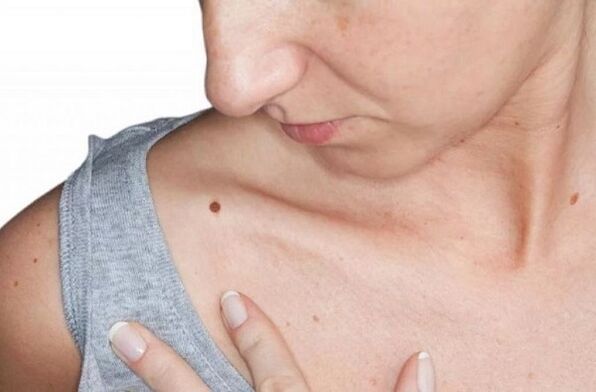If analysis is needed to identify HPV, then there is nothing to worry about. Most procedures are completely painless and some are well tolerated by any patient. Consider the most common questions about running tests.
What is HPV?
Human papillomavirus is a microorganism that contains the cell structure of DNA. When introduced into the human body, HPV DNA causes a mutation that leads to irreversible processes. Most of the population already carries the virus, but few people are aware of this as the virus does not manifest itself in any way.
Once the body fails, the immune system weakens and growths appear on the body. With all formations on the skin, with the exception of moles and acne, HPV is affected. If the growths are not treated in time, malignancy occurs and a harmless wart can become cervical cancer in women and urethral cancer in men.
Why is the human papilloma virus dangerous?
When papillomas, genital warts or warts appear on the body, an ordinary person can hardly distinguish them from each other and mistake them for something incapable of causing harm.
It's not that simple - a small papilloma can grow so large that it causes a lot of inconvenience - from aesthetic discomfort to the development of cancerous tumors. More than 130 strains of the human papillomavirus are known and each of them manifests itself in different ways.

The most common of them are types 16 and 18, which cause cancer of the mucous membranes, cervix, vagina, penis, and other similar diseases. Since a person does not know anything about the presence of the virus in the body at first, HPV gradually develops and after 5-10 years a person sees changes in their body in the form of growths.
The analysis for papilloma can be carried out in any clinic. After 40 years, more than half of the lesions become malignant. Timely diagnosis gives a person the chance of a pain-free old age that is not overshadowed by cancer.
Why test for human papillomavirus?
In order to protect yourself from oncogenic diseases, you should identify a potential threat to life and health in a timely manner. With an extensive list of reasons for its spread, HPV is transmitted from person to person through close contact - hugs, kisses, sexual intercourse, use of common hygiene products.
The virus takes root under the skin, destroys the healthy DNA structure and mutates throughout the body. When immunity fails, HPV appears on the skin in the form of warts, papillomas, and similar rashes. Only an investigation can detect the virus at an early stage and block its further spread.
When is an HPV test planned?

When the first signs of the disease appear on the body, the doctor may even see them during a visual examination. An HPV test is prescribed to understand where the virus came from in the body, identify the type, and then eliminate it.
Even when you consider that not everyone who is infected can become a cancer patient, nobody wants to challenge fate, which is why tests are necessary. If a woman is planning to become pregnant, she must be tested for HPV because the virus can easily get into the baby. The father should not be indifferent either, because he can be a carrier of the papillomavirus.
Features of the passing of the analysis for HPV
It is believed that the detection of HPV before the age of 30 is not meaningful because the disease extends far beyond the human eye. After 30, the first tests are prescribed, which can detect papillomaviruses at an early stage.
The less time has passed since the infection, the more effective the subsequent treatment will be. It is necessary to identify the moment when normal cells grow into cancer cells. The methods of diagnosing human papillomavirus depend on several factors:
- Identification of the virus and the fact of its presence in the body
- Discover the diversity
- Assess the damage caused during the period when the person did not seek medical help
- Prescribe quality and effective treatment
Notice:the virus will never leave the host completely because it is already interacting with the cells of the body's own DNA. HPV stays calm until the immune system is weakened.
What kind of analysis should be passed on for the detection of HPV?
- Colposcopic examination. HPV testing in women is done using this method. It is designed to help identify genital warts. Women are prescribed to detect genital warts on the neck area.
- Cytology. A smear containing epithelial cells is taken, then the collected samples are examined under a microscope. If the cells are changed, there is a risk of developing HPV. There is a risk of a wrong result.
- Histology. It is a supplement to cytology to rule out a mistake. A small piece of the affected tissue is removed and the doctor assesses the difficulty of the position through a microscope. With the help of histological examination, it is possible to determine the type of formation.
- PCR diagnostics. The most honest way with 98% accuracy. Swab, urine, blood or amniotic fluid taken
If at least one examination reveals the presence of a virus, the patient is sent for further analysis to ensure the accuracy of the result. If the result was false positive, contaminated test material or a violation of generally accepted sampling procedures may be the cause.
Sometimes patients prepare incorrectly for the analysis or choose the wrong time for the procedure - these factors, too, can lead to incorrect results.
Test rules
The patient does not have to rely only on the attending physician, but has to follow the process of passing the analysis himself and know the basic processes. The doctor is a specialist, but health belongs to the patient.
How is biomaterial absorbed?
The strokes are picked up with a soft brush that looks like a paintbrush. A Volkmann spoon is sometimes used in independent clinics - it's a small spoon on a long handle. Such a brush is carefully inserted into the canal and then removed with a twisting motion. The brush is placed in a sterile bottle and sent for further research.
How to prepare for the procedure for women
2 days before the procedure, you can not live sexually, use soap with antibacterial properties, take a shower, use tampons. If a smear was taken from the cervix, you can not have sex, play sports, overheat, swim in public places, and take drugs that affect blood thinning for 3 weeks after the procedure.

How to prepare for the procedure for men
Sexual intercourse is excluded, shower for 2 days without detergent. Do not urinate before the procedure.
General preparation for the procedure
It is necessary to inform the doctor of all medications that a person has taken in the past 2 months.
How is an HPV blood test done?
Used for PCR diagnostics. From a finger, sometimes from a vein, depending on the type of analysis the person will be doing. A slight tingling sensation from the injection is the major discomfort of the procedure. If the vessels in the elbow area are narrow, it will be difficult to draw blood, but the doctor will tell you how to properly widen the vein.
The procedure is carried out on an empty stomach, you can not even drink water. It is advisable to take a candy bar with you. 3 days before the blood donation, it is necessary to exclude from the diet all foods that cause an allergic reaction.
How is urine tested?
Better to take care of the sterile jar yourself. You can buy it at the pharmacy. Collect morning urine in a glass on an empty stomach. Then take it for examination, preferably immediately, the maximum duration is 4 hours or the result is invalid. The method is not as accurate as taking blood, but if blood donation is not possible, then this method must be used.

How long does an HPV test take in women and men?
If a colposcopic examination has taken place, the result is given immediately. In the case of a cytological examination, the results are only available after a week. The histology is done for 3 days, then you can get the test result on your hands. With PCR diagnostics, you can take the results immediately or wait up to 2 days.
When and how often should you get tested for HPV?
Up to the age of 30, only those who show clear signs of growths on the body are examined. Usually at this age, HPV dormant and does not spread throughout the body.
From 30 to 60 years old, it is necessary to go for an examination every 3 years. Immunity decreases, so the signs of human papillomavirus should be detected in a timely manner.
As a rule, no more examinations are carried out after 60 years. If the last two tests did not detect a virus, then there is nothing to worry about. If there have been any manifestations, then you need to seek treatment until the last 2 results are negative.
Costs and prices for the delivery of HPV tests
Most examinations are free of charge if you have an acute illness or if you have completed a cancerous tumor. They can be prescribed by the treating oncologist.
For a full picture of the evolution of the virus, 2 methods are usually used to exclude the likelihood of incorrect information.
Decryption of the results
The decryption should only be carried out by the attending physician. Patient intervention brings no good. To understand what the results are about, look out for the following words:
- reference values - HPV absent;
- positive result - an oncogenic HPV strain has been detected;
- the result is negative - no cancerous manifestations were found, but there is a possibility of finding other types of HPV.
If the patient has decided to get well and find out the presence of the human papillomavirus in his body, then one should resort to the above methods. Timely diagnosis has saved millions of people and contributed to calm, healthy lives. Only after thoroughly passing the tests is it possible to prescribe quality treatment.
Sometimes the patient is sent for tests with no external signs of the disease, and the procedure shows that HPV is present in the body. In this case, the treatment does not last long. For this reason, doctors recommend seeking help in a timely manner.













































































